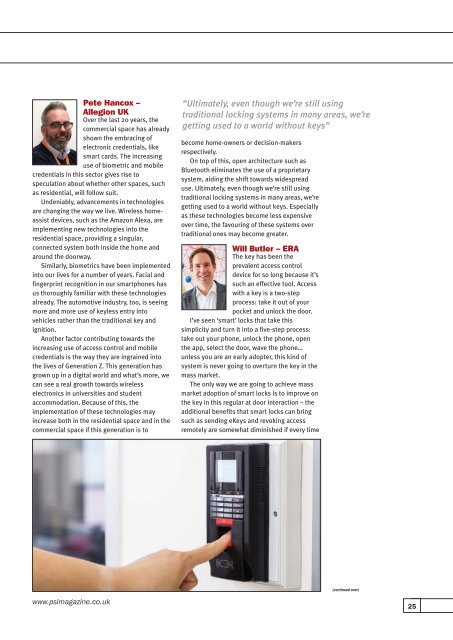PSIJuly2018
You also want an ePaper? Increase the reach of your titles
YUMPU automatically turns print PDFs into web optimized ePapers that Google loves.
Pete Hancox –<br />
Allegion UK<br />
Over the last 20 years, the<br />
commercial space has already<br />
shown the embracing of<br />
electronic credentials, like<br />
smart cards. The increasing<br />
use of biometric and mobile<br />
credentials in this sector gives rise to<br />
speculation about whether other spaces, such<br />
as residential, will follow suit.<br />
Undeniably, advancements in technologies<br />
are changing the way we live. Wireless homeassist<br />
devices, such as the Amazon Alexa, are<br />
implementing new technologies into the<br />
residential space, providing a singular,<br />
connected system both inside the home and<br />
around the doorway.<br />
Similarly, biometrics have been implemented<br />
into our lives for a number of years. Facial and<br />
fingerprint recognition in our smartphones has<br />
us thoroughly familiar with these technologies<br />
already. The automotive industry, too, is seeing<br />
more and more use of keyless entry into<br />
vehicles rather than the traditional key and<br />
ignition.<br />
Another factor contributing towards the<br />
increasing use of access control and mobile<br />
credentials is the way they are ingrained into<br />
the lives of Generation Z. This generation has<br />
grown up in a digital world and what’s more, we<br />
can see a real growth towards wireless<br />
electronics in universities and student<br />
accommodation. Because of this, the<br />
implementation of these technologies may<br />
increase both in the residential space and in the<br />
commercial space if this generation is to<br />
“Ultimately, even though we’re still using<br />
traditional locking systems in many areas, we’re<br />
getting used to a world without keys”<br />
become home-owners or decision-makers<br />
respectively.<br />
On top of this, open architecture such as<br />
Bluetooth eliminates the use of a proprietary<br />
system, aiding the shift towards widespread<br />
use. Ultimately, even though we’re still using<br />
traditional locking systems in many areas, we’re<br />
getting used to a world without keys. Especially<br />
as these technologies become less expensive<br />
over time, the favouring of these systems over<br />
traditional ones may become greater.<br />
Will Butler – ERA<br />
The key has been the<br />
prevalent access control<br />
device for so long because it’s<br />
such an effective tool. Access<br />
with a key is a two-step<br />
process: take it out of your<br />
pocket and unlock the door.<br />
I’ve seen ‘smart’ locks that take this<br />
simplicity and turn it into a five-step process:<br />
take out your phone, unlock the phone, open<br />
the app, select the door, wave the phone…<br />
unless you are an early adopter, this kind of<br />
system is never going to overturn the key in the<br />
mass market.<br />
The only way we are going to achieve mass<br />
market adoption of smart locks is to improve on<br />
the key in this regular at door interaction – the<br />
additional benefits that smart locks can bring<br />
such as sending eKeys and revoking access<br />
remotely are somewhat diminished if every time<br />
(continued over)<br />
www.psimagazine.co.uk<br />
25

















